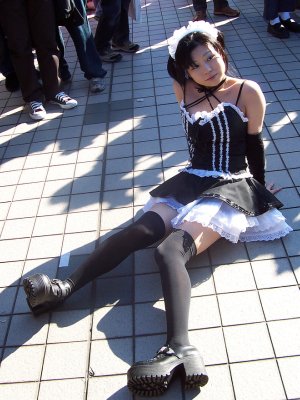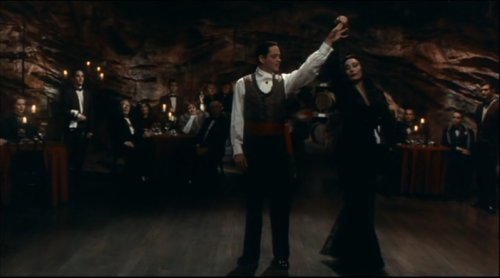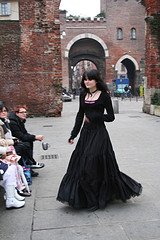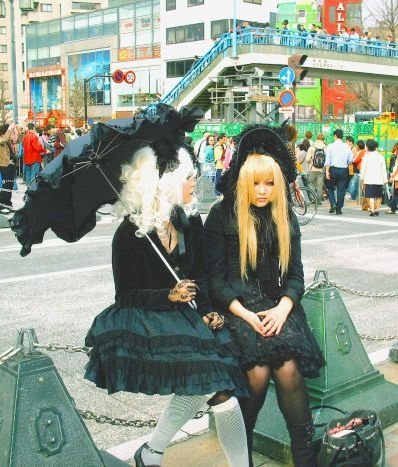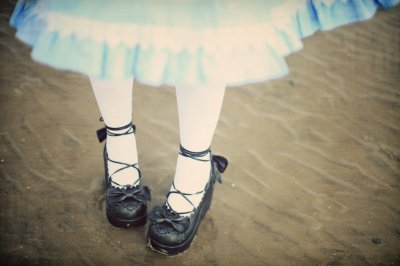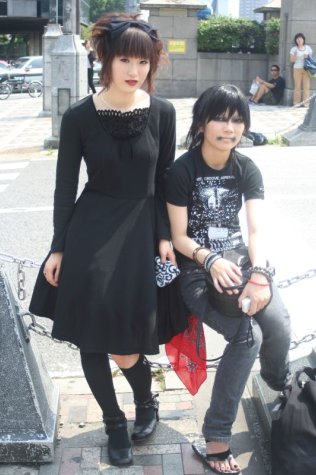|
Gothic Lolita
Gothic lolita is a Japanese youth subculture, popular among young women in and outside of Japan. Goth loli, or ゴスロリ, combines the dark aesthetic of goth fashion with a frilly, feminine style popularized by visual kei bands, especially Mana, of Moi-même-Moitié fame. This style also owes a debt of influence to John Tenniel's illustrations of Alice in Wonderland and porcelain dolls. Lolita fashion started in the 1990s, in the Kansai region of northern Japan. In the past ~15 years, lolita styles (especially goth lolita) have spread from Tokyo to East Asia to the United States and even to Europe. In Tokyo, gothic lolita is big business. Retailers like Atelier Boz and Baby, the Stars Shine Bright market their wares through billboards, magazines and high profile ad campaigns. Mangas like Paradise Kiss and The Melancholy of Haruhi Suzumiya reflect and popularize the goth loli look. Although most people associate this style Vladimir Nabokov's Lolita, the connection is indirect at best. Lolita fashion is childlike and doll-like, not sexual or nymphettish; goth loli accessories often borrow religious iconography, especially crosses. The emphasis is on youthfulness, on looking cute rather than sexy. Kinderwhore fashion, an antecedent to lolita fashion, is more sexualized (hence the name); in some ways, kinderwhore is an inverted lolita aesthetic. Lolita fashion, in general, may be a way for young women to express their femininity while remaining modest. The style is certainly more popular with women than men. One follower of lolita fashion explained it thus: Frequently, female sexuality is portrayed in a way that is palatable and accessible to men, and anything outside of that is intimidating. Something so unabashedly female is ultimately kind of scary...Dressing this way takes a certain kind of ownership of one’s own sexuality that wearing expected or regular things just does not. It doesn’t take a lot of moxie to put on a pencil skirt and flats. It’s not, as some commentors have suggested, some sort of appeal to men’s expectation that women should be childlike, or an attempt to pander to pedophiles. Pedophiles like little girls. They don’t like grown women who happen to like dresses with cakes on them.Lolita fashion, gothic or otherwise, typically shows very little skin, basically the hands, calves and neck. To understand the aesthetic differences between gothic lolita and goth culture, one only has to take a look at the differences between a stereotypical "goth dress" and an equally stereotypical "goth loli" outfit.
The "Morticia dress" is floor-length, with a scoop or plunging neckline and long sleeves, often extending past the wrists. This dress is also tight, emphasizing the curves of the female form. A dress of this type would look faintly ridiculous on any woman under twenty-five, if not thirty. A certain self-awareness is required to pull this look off. You might have a body that would make Megan Fox green with envy, but if you're not confident in your sexuality, you'll open yourself up to ridicule. Morticia's makeup (and Vampira's, and Elvira's) is exceedingly pale, with dark, dramatic eyes and red lips. Long, black hair extends from the head down to the middle of the bust in a straight line, with no layers or bangs. An austere look, that can look comical if not pulled off right. Of course, young women can pull off this look, often by wearing an ankle-length dress with a scoop neckline and wrist-length sleeves.
This is a fetching look on most young women, in black or another dark color. It harkens back to the past while being sufficiently modern, and a scoop neck is alluring without being obscene. Makeup is also subtler; at that age, why gild the lily? Now that we've covered one stereotype, let's move on to the next one:
The skirts above are short, at or just below knee-length. They make a "bell" shape when the women stand up, held up by boning and by petticoats. Despite the skirt's shortness, very little of these women's bodies are revealed: their hands, knees and calves are basically all we can see. Even the shapes of these girls's bodies are obscured beneath the fabric. Their makeup, if any, is subtle. According to the Gothic and Lolita Bible, whiteface is considered very bad taste in this movement, while red lipstick and subtle smokey eyes are very in. Gothic lolitas tend to wear Mary Janes, a shoe type popular with young women. This also resembles the children's shoes worn by Alice in Alice in Wonderland, especially when they're black patent leather.
Like many Japanese subcultres, goth lolita is more about shared fashion than about shared tastes and interests. Different gothic lolitas may listen to radically different music, but they are united by their interest in and dedication to this style. It's a bit like the Teddy Girls of 1950s London; members may have many things in common, but their statement is a fashion statement first, and an expression of philosophy second.
Related Reading: Return to Enjoy Your Style's subcultures section. Return to Enjoy Your Style's home page. Search Enjoy Your Style: |





